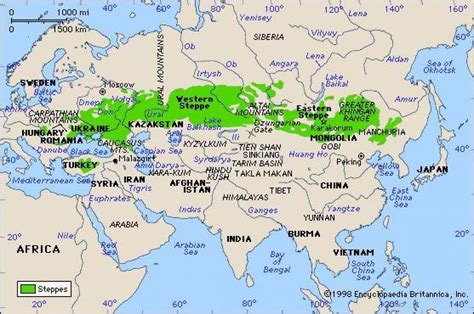Russian Steppes Map
The vast steppes of Eurasia have fascinated people for centuries with their seemingly endless expanse of grassland. Covering a large portion of the continent, these grasslands encompass habitats and civilizations as diverse as the nomadic herders of Central Asia and the urbanized areas surrounding the Black Sea. While it may seem like an endless sea of grass, the Eurasian steppe is a unique and complex ecosystem that has a crucial role in the world's environment. The steppe biome is characterized by its grassy plains with scattered trees and shrubs. Its continental climate means that temperatures can be extreme, and rainfall is irregular. The steppe coverings range from short-grass prairie in the west to tall-grass steppes in the east. It's also home to various animal species, including the Przewalski's horse, saiga antelope, and wild boar. For thousands of years, the Eurasian steppe has been home to numerous different cultures and civilizations. From the nomadic horsemen who roamed the plains to the agricultural societies that developed in the river valleys surrounding the steppes, the region has been a hub for different peoples and ethnic groups. It has also played a crucial role in world history, serving as a crossroads of trade, communication, and conflict. One notable civilization that originated in the steppe region was the Scythians. These nomadic peoples inhabited the pontic steppe, the region surrounding the Black Sea, in the 7th to 3rd centuries BCE. They were skilled horsemen and archers, and their way of life centered around hunting and herding. Their fierce reputation and military prowess made them a force to be reckoned with, even by the great empires of their time. Another notable aspect of the Eurasian steppe is its ecology. The grasslands support a diverse range of flora and fauna, including many endemic species. The steppe provides an oasis in the middle of the vast continent, a refuge for migratory birds, and a vital habitat for large herbivores. It also plays a crucial role in the carbon cycle, storing large amounts of carbon in its soils and vegetation. However, the steppe ecosystem is also fragile and under threat. The rapid expansion of human populations and agricultural practices has led to the degradation of the grasslands. Overgrazing, plowing, and soil erosion have contributed to the shrinking of the steppe region and the loss of biodiversity. Climate change poses an additional risk, with rising temperatures and changing precipitation patterns potentially disrupting the unique balance of the ecosystem. In conclusion, the Eurasian steppe is a unique and multifaceted region that has played a pivotal role in human history and ecological balance. It's home to diverse cultures, species, and landscapes, but it is also under threat from human activities and climate change. Protecting the steppe and finding sustainable ways to manage its resources are crucial for safeguarding its biodiversity and ensuring its continued role in the world's environment. 

it.maps-russia.com
www.britannica.com




Post a Comment for "Russian Steppes Map"